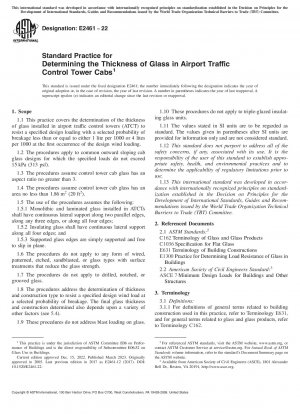ASTM E2461-22
Standard Practice for Determining the Thickness of Glass in Airport Traffic Control Tower Cabs
- Standard No.
- ASTM E2461-22
- Release Date
- 2022
- Published By
- American Society for Testing and Materials (ASTM)
- Latest
- ASTM E2461-22
- Scope
- 1.1 This practice covers the determination of the thickness of glass installed in airport traffic control towers (ATCT) to resist a specified design loading with a selected probability of breakage less than or equal to either 1 lite per 1000 or 4 lites per 1000 at the first occurrence of the design wind loading. 1.2 The procedures apply to common outward sloping cab glass designs for which the specified loads do not exceed 15 kPa (313 psf). 1.3 The procedures assume control tower cab glass has an aspect ratio no greater than 3. 1.4 The procedures assume control tower cab glass has an area no less than 1.86 m2 (20 ft2 ). 1.5 The use of the procedures assumes the following: 1.5.1 Monolithic and laminated glass installed in ATCTs shall have continuous lateral support along two parallel edges, along any three edges, or along all four edges; 1.5.2 Insulating glass shall have continuous lateral support along all four edges; and 1.5.3 Supported glass edges are simply supported and free to slip in plane. 1.6 The procedures do not apply to any form of wired, patterned, etched, sandblasted, or glass types with surface treatments that reduce the glass strength. 1.7 The procedures do not apply to drilled, notched, or grooved glass. 1.8 The procedures address the determination of thickness and construction type to resist a specified design wind load at a selected probability of breakage. The final glass thickness and construction determined also depends upon a variety of other factors (see 5.4). 1.9 These procedures do not address blast loading on glass. 1.10 These procedures do not apply to triple-glazed insulating glass units. 1.11 The values stated in SI units are to be regarded as standard. The values given in parentheses after SI units are provided for information only and are not considered standard. 1.12 This standard does not purport to address all of the safety concerns, if any, associated with its use. It is the responsibility of the user of this standard to establish appropriate safety, health, and environmental practices and to determine the applicability of regulatory limitations prior to use. 1.13 This international standard was developed in accordance with internationally recognized principles on standardization established in the Decision on Principles for the Development of International Standards, Guides and Recommendations issued by the World Trade Organization Technical Barriers to Trade (TBT) Committee.
ASTM E2461-22 Referenced Document
- ASTM C1036 Standard Specification for Flat Glass
- ASTM C162 Standard Terminology of Glass and Glass Products
- ASTM E1300 Standard Practice for Determining Load Resistance of Glass in Buildings*, 2024-03-01 Update
- ASTM E631 Standard Terminology of Building Constructions
ASTM E2461-22 history
- 2022 ASTM E2461-22 Standard Practice for Determining the Thickness of Glass in Airport Traffic Control Tower Cabs
- 2017 ASTM E2461-12(2017) Standard Practice for Determining the Thickness of Glass in Airport Traffic Control Tower Cabs
- 2012 ASTM E2461-12 Standard Practice for Determining the Thickness of Glass in Airport Traffic Control Tower Cabs
- 2005 ASTM E2461-05(2011) Standard Practice for Determining the Thickness of Glass in Airport Traffic Control Tower Cabs
- 2005 ASTM E2461-05 Standard Practice for Determining the Thickness of Glass in Airport Traffic Control Tower Cabs
